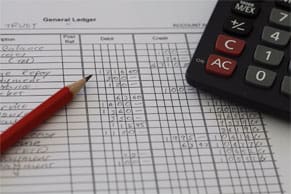What you charge customers should reflect both direct and indirect production costs while achieving your desired profit margin. To accurately track those costs, manufacturers typically use either job order costing or process costing. One is ideal for custom products, where costs are tracked per customer order. The other is better suited for mass production, with costs broken down at each stage of a standardized process. Job order costing and process costing both have advantages and drawbacks, so companies must carefully consider which method best fits their business model.
What Is Job Order Costing?
Job order costing helps track costs associated with each order, or “job.” It’s a good fit for companies that create unique products, whether individually or in small batches. Costs are broken down into labor, materials, and overhead, with the primary goal of understanding the profit or loss for each order. Many companies use job costing tickets to document each job’s labor hours, material usage, and overhead.
This process involves comparing actual costs to estimates to help uncover inefficiencies, such as repetitive work or misallocated resources. A job order costing system also uses this information to help set prices that entice customers yet allow the company to remain profitable.
What Is Process Costing?
Process costing calculates production costs at each stage of a manufacturing process. This makes it ideal for companies that mass-produce identical or nearly identical items, such as screws or packaged snacks, whose costs would be incredibly difficult to track individually. As in job order costing, costs are broken down into labor, materials, and overhead to determine the total cost of production. But costs are then accumulated for each process stage and allocated evenly across all units produced during a period to derive an average cost per unit.
Process costing can also be used to help assess profitability or identify opportunities for process improvements.
Key Takeaways
- Job order costing and process costing are two ways to calculate production costs, each used for different purposes.
- Job order costing tracks costs and inventory per job and works best for specialized products made in small batches.
- Process costing tracks costs and inventory per production run or period and is ideal for mass-produced items.
- Regardless of the cost accounting method a company chooses, it’s imperative to separate direct and indirect costs before developing forecast budgets, creating accurate forecasts, and assessing profitability.
Why Is It Important to Pick the Right Costing Method?
Job order costing and process costing are the two cost accounting methods used to track product costs, allocate resources, and calculate unit costs. Which methodology to use depends on the types of products a company makes and how it makes them. Choosing incorrectly can lead to misallocated costs, pricing issues, and even compliance risks, whereas use of the right method can help manufacturers to:
- Accurately allocate costs: Choosing the correct cost accounting process helps companies properly assign costs to products. Accurate cost allocation is especially important for mass-produced goods, where even small cost miscalculations can be multiplied by the thousands or millions of items, leading to pricing errors and lost profits.
- Accurately analyze profitability: Job order costing makes it possible to easily identify which projects are most lucrative, or to adjust pricing strategies for future projects to avoid undercharging for the work. Process costing simplifies profitability analysis for high-volume production, making it possible to see how changes in production volume affect profitability or show how different product lines or departments contribute to profitability.
- Pick the right pricing strategy: The right cost accounting method supports pricing decisions that balance profitability with market competitiveness and customer value perception. Custom products tend to have higher profit margins due to their uniqueness. For these goods, job costing helps the maker determine the minimum price needed to achieve a particular profit margin for that specific sale. Process costing, suited for mass-produced items, provides average cost information that supports competitive pricing in high-volume markets. It helps companies identify ways to reduce costs, improve production efficiency, maintain margins, and remain price-competitive.
- Maintain cost control: Different cost control strategies align with different cost accounting methods. Job order costing benefits from estimating costs up front by allowing companies to identify potential cost overruns early and make adjustments during production. On the other hand, process costing supports various management approaches, such as lean accounting to streamline production, target costing to limit increases in production costs, or standard costing to reflect typical operating conditions.
- Track inventory: The chosen cost accounting method impacts how a company tracks and values its raw materials, work in process (WIP) and finished products—which is essential for financial reporting and tax compliance (discussed below). Choosing the wrong method can result in incorrect inventory valuation, distorted financial statements, or poor management decisions.
- Stay compliant with tax regulations: Choosing the appropriate cost accounting method is key to maintaining tax compliance. The selected method directly impacts how costs are allocated to products, which, in turn, affects inventory valuation, cost of goods sold, and, ultimately, taxable income. Using the wrong method could lead to inaccurate financial statements and tax returns, potentially resulting in penalties from tax authorities.
Job Order Costing vs. Process Costing: Key Differences Explained
There are some similarities between job order costing and process costing methods. At their core, both aim to determine the material, labor, and overhead costs associated with production so companies can set competitive prices and make informed business decisions.
However, there are also notable differences related to the way costs are calculated, the type of item being made and how it’s produced, how production costs are calculated, and even the industry. These differences are explained in detail below.
Cost Calculation Method
Job order costing calculates costs for each individual product made, as jobs are typically completed to match a customer’s unique requirements. Companies often present the cost to a customer in the form of an itemized estimate provided prior to production, plus an itemized bill tendered upon completion.
Process costing calculates costs based on the production process and the number of units produced in a period or run. If production conditions among different items are minimal, costs are averaged for all items produced in that time, even if there are minor variations. For example, a hat manufacturer may need to make only a small change to the settings on one machine to transition from a batch of 2,000 red hats to 2,000 blue hats, rather than having to change the entire production process.
Production
The way a company produces items largely determines the cost accounting method. If a company works in small batches or on a single product at a time, job order costing is the better, more accurate fit, as it allows costs to be assigned to each specific job.
Process costing is more practical for continuous production, where identical or near-identical items are made in large quantities in a series of repetitive tasks. In this case, it’s easier to aggregate costs for a set number of units produced in a given time frame than it is to track costs for an individual item among thousands produced, which would require extensive recordkeeping.
Type of Product
Job order costing is appropriate for small batches of unique items produced as individual job orders, often with varying client requirements. This allows for more precise cost accounting, as labor, overhead, and materials differ for each job.
On the other hand, mass-produced items with standardized processes benefit from process costing, since costs are averaged across all units rather than tracked individually. For example, a business that makes custom bookcases would use job order costing, while a business fulfilling an order for 500 bookcases would use process costing.
Cost Tracking
In job order costing, companies accumulate and track costs per individual job. Job costing tickets, which are often used to track these costs, provide a detailed record of time spent, materials used, and other job-specific expenses. Customers typically receive an estimate of costs at the beginning of production and a detailed bill upon completion. This method provides precise job-specific data but can be difficult to scale, as time and materials are charged to individual jobs.
In process costing, costs accumulate and aggregate by each step of the production process. There’s little to no emphasis on tracking the exact cost of individual items being produced, as hundreds or thousands of items are made at a time. Though less precise for individual items, process costing efficiently handles high-volume production. Additionally, process costing must account for waste and shrinkage, as not all materials convert into finished goods. Normal losses, such as evaporation in chemical production or material scraps in textile manufacturing, are factored into cost calculations.
Overhead
Regardless of the production process or types of items made, companies need to assess overhead allocations. Overhead includes rent, utility bills, and other business expenses tied to manufacturing costs but otherwise unrelated to the goods being produced.
Job order costing assigns overhead to individual jobs. Companies typically assess a predetermined allocation rate based on an appropriate base, such as labor hours or machine time, depending on the nature of the job. For example, if a company’s overhead rate is $20 per labor hour and a job takes 10 hours, $200 of overhead would be allocated to that job (10 hours x $20).
In process costing, overhead is spread across all units produced in a production process or department. The total overhead is divided by the number of units produced, giving an average overhead cost per unit. Therefore, if a department’s monthly overhead is $50,000 and it produces 10,000 units, the overhead cost per unit would be $5 ($50,000 / 10,000 units)
Inventory
There are four major categories of inventory: raw materials, WIP, finished products, and maintenance, repair, and operating (MRO) supplies As with cost calculation and tracking, companies using job order costing calculate and manage inventory for each job. Raw materials are requisitioned for specific orders, WIP is tracked separately for each, and finished goods consists of completed jobs that haven’t been sold. MRO, however, is usually tracked overall rather than by individual job.
In process costing, inventory is tracked by production stage. Raw materials and works in process are monitored at the department level, and the company manages a single inventory account for finished goods. As with job costing, MRO supplies are tracked collectively.
When valuing inventory in process costing, companies can apply different cost flow assumptions to determine unit costs. The weighted average cost method calculates a blended cost based on all units available during the period. First in, first out (FIFO) assumes the earliest units produced are the first to be sold, while last in, first out (LIFO) assigns the most recent costs to units sold first.
Industry
As job order costing and process costing are typically used for different production processes, it should come as no surprise that different industries tend to adopt the costing method that best suits their operational characteristics.
Companies in industries that produce unique orders for products or services—such as couture fashion designers, consulting firms, and hospitals—generally use job order costing.
Manufacturers of a single product, or variations of a single type of product, tend to use process costing. Industries in this segment commonly include food production, chemical processing, and mass production of goods, such as textiles, cement, and paint.
Side-by-Side: Job Order Costing vs. Process Costing
| Features | Job Order Costing | Process Costing |
|---|---|---|
| Cost Calculation Method | Calculated for each individual job and/or product made | Calculated based on each step of the production process and the number of items made |
| Production | Small batches of products, or products made one at a time | Continuous operation of mass-produced items |
| Type of Product | Unique items, often with varying requirements from one order to another | Mass-produced items with standardized steps for production |
| Cost Tracking | Accumulated and tracked for individual jobs | Accumulated and aggregated for each step of production |
| Overhead | Spread across different jobs, based on how much work each job needs | Calculated as an average of all items produced |
| Inventory | Tracked separately for each specific job or order | Tracked by production department or process stage |
| Industry | Custom manufacturing, consulting, healthcare, construction | Food production, chemical processing, consumer goods, automotive manufacturing |
When to Use Job Order Costing
Job order costing is appropriate for individualized or specialized products made in small batches. Since these products have unique requirements, varying materials, and different labor demands, tracking costs per job is necessary for accurate cost allocation, to set custom pricing, and to most effectively control costs.
Example: Custom Home Furniture
Imagine a company that makes bookcases, tables, and other pieces of furniture as custom orders for high-end homes. Each piece requires different raw materials, and labor costs vary according to design complexity. To get an accurate cost assessment, the company must track expenses for each job. This includes assigning a fair share of overhead costs based on estimated usage to complete that job.
This method will result in accurate estimates and final bills for customers, and it will help the company determine which jobs are the most profitable. Attempting to do this using process costing would be impractical because of the variation in costs and number of production steps from one item to another.
When to Use Process Costing
Process costing is preferable when a company has standardized processes for producing items in bulk. Tracking costs for each item would be highly inefficient and impractical, so companies focus instead on monitoring the total costs for each step of production and average them across all units in a batch, run, or time period.
Example: Bulk Office Furniture
Now imagine a company that manufactures bookcases, desks, and tables for commercial buildings. Customers typically order hundreds of identical pieces at a time to furnish large office spaces. To meet demand efficiently, the furniture company follows a standardized production process. Each cubicle desk is the same size and comes with the same shelves and cabinets; each bookcase uses identical hardware to allow for adjustable shelving.
For a company producing at this scale, job order costing wouldn’t be practical, as tracking costs per individual item would be extremely time-consuming. Instead, leadership adopts process costing to track expenses for each production step, such as cutting desk pieces, assembling components, and applying finishes. This allows the company to assess costs holistically, making it easier to see where seemingly small changes, such as adjusting production line scheduling or using a different varnish, could improve efficiency or reduce direct material costs.
Requirements for Setting Up a Costing Method
Before setting up a costing system, a company needs to identify and separate its direct and indirect costs. Direct costs, such as labor and materials, are linked, as the name implies, directly to production. In job order costing, direct costs are tracked per job. In process costing, the costs for the entire production run are averaged out to disclose a per-unit amount.
Indirect costs, such as rent, utility bills, insurance premiums, and other overhead expenses, are not directly linked to a single product and must be allocated using an overhead allocation method, such as by setting a predetermined overhead rate. In job order costing, overhead is fairly allocated to each job. In process costing, it’s distributed across all units in a production stage. Accurately calculating overhead costs is critical for pricing products appropriately, assessing profitability, forecasting budgets, and identifying opportunities to improve efficiency.
Leading accounting and enterprise resource planning software systems include allocation methods, such as predetermined overhead rates, to help companies make accurate calculations and apply overhead costs consistently.
Hybrid Costing Approaches
Some companies operate what’s known as a “mixed production system.” One example is a company that makes standard versions of one type of product but custom orders of another, such as a bakery that makes dozens of muffins every morning and one custom wedding cake per week. The bakery would likely choose process costing for the muffins, and job order costing for its custom cakes.
Another example would be items initially made in large quantities but customized before shipment. This is common for products with similar “bones” and personalized finishes, such as one couch with multiple fabric options or kitchen cabinets featuring various finishes. A company with this type of production system might benefit from process costing for the initial stages of production, when work is done in large batches, and then job order costing for the final customizations.
Companies using hybrid costing need to make sure their accounting systems can support both methods efficiently. If the job order costing and process costing aren’t integrated within the same software, data may need to be manually transferred, which often leads to errors and inefficiencies in cost tracking and financial reporting. To get the most out of hybrid costing, companies should also analyze production data to identify cost-saving opportunities, such as shifting certain manufacturing steps from job order costing to process costing where standardization is possible.
Optimize Financial Controls With NetSuite Cloud Accounting Software
Whether companies use job order costing or process costing, managing production costs and tracking profitability can quickly get complicated. Siloed data on key cost drivers—such as raw materials, labor, and overhead—makes it difficult to get a real-time view of production expenses and accurately forecast costs.
NetSuite Cloud Accounting Software centralizes cost data and integrates seamlessly with inventory, order management, and financial reporting, helping business track expenses across every stage of production. By unifying these processes within a single platform, companies can see how production costs affect profitability and access the data needed to improve efficiency and pricing strategies.
A company’s chosen method of strategic cost accounting largely boils down to the types of products they make and how they make them. Job order costing focuses on every cost associated with producing custom items individually or small batches, while process costing looks at the cost of each stage of production for mass-produced items. Though these methods differ in how they allocate overhead and how they track material and labor costs, the underlying goal is the same: to help companies set competitive prices, make informed business decisions, and ensure long-term profitability.
Job Order Costing vs. Process Costing FAQs
What are the four types of costs?
In accounting, costs are commonly classified into four categories:
- Variable costs, which change based on the number of items produced, such as raw materials and packaging.
- Fixed costs, which are constant regardless of production levels, such as rent, insurance premiums, and salaries.
- Direct costs, which are directly associated with the production of goods or services, such as labor and raw materials.
- Indirect costs, which support production but aren’t directly linked to a specific product, such as utilities and factory maintenance.
What are the seven steps in job order costing?
Job order costing can be broken down into seven steps:
- Identify the cost categories for each job, such as direct materials, direct labor, and overhead.
- Attribute direct costs to the specific job.
- Allocate indirect costs to the job, using a predetermined rate or other suitable allocation method.
- Record and track costs in an accounting or enterprise resource planning system throughout production.
- Calculate the total job cost by adding up direct and allocated indirect costs.
- Compare the cost of the job to the revenue generated to assess profitability and pricing accuracy.
- Routinely review and analyze job costing data to identify inefficiencies and improve cost management.
What are the five steps in process costing?
Process costing can be broken down into five steps:
- Track the movement of materials, labor, and overhead through each stage of production.
- Account for partially completed products.
- Determine total production costs by adding direct materials, direct labor, and overhead costs incurred during the production period.
- Calculate the cost per unit by dividing total production costs by the number of finished and in-progress units.
- Allocate costs to completed products and any inventory still in production.








